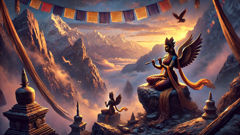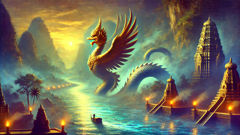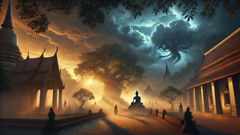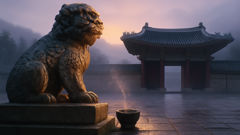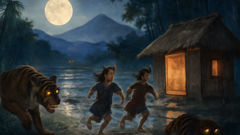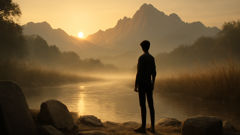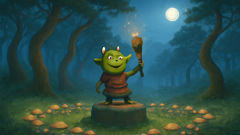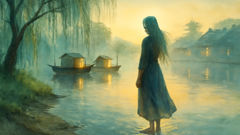Introduction
In the soft dawn light that spills across the ancient lands of southwestern Australia, the earth still remembers the paths of its oldest inhabitants. Among the towering jarrah and marri trees, where the bush vibrates with the calls of cockatoos and the perfume of wildflowers drifts on the wind, the rivers flow like shimmering ribbons—veins of life carved into the land. These rivers are more than water; they are the living memory of creation, and at the heart of their story is the Wagyl, a mighty snakelike being revered in Noongar Aboriginal mythology. The Wagyl is not just a creature, but a spirit—protector, creator, and keeper of the waterways. Its sinuous body is said to have shaped the curves and bends of the Swan and Canning Rivers, and its spirit still dwells within their depths, keeping the balance between land, water, and all living things. For the Noongar people, these stories are not merely old tales but sacred truths: they teach respect for country, the interconnectedness of all life, and the reverence due to the land’s guardians. As the rivers sparkle under the morning sun, winding past reeds and ancient rocks, you can almost sense the powerful presence of the Wagyl, coiled beneath the surface, watching, waiting, and reminding all who listen that every place has its story, every bend its purpose. This is the story of how the Wagyl came to shape this land—a story as deep and winding as the rivers themselves.
The Dreaming: When the Land Was Young
Long before humans walked the earth, when time itself was still in its infancy, the land was a formless expanse of raw potential. There were no rivers, no hills, no forests—only a vast plain beneath an endless sky. In this primordial world, spirits moved freely. They were ancient beings, each one a force of nature, boundless and potent. Among them was the Wagyl, the great rainbow serpent, whose scales shimmered with every color of the bush—the deep green of eucalyptus leaves, the ochre reds of earth, the bright gold of wattle blossom, and the midnight blue of river shadows.
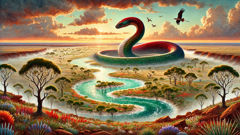
The Wagyl was restless in this empty land. It felt the dryness of the plains and longed for cool water to nourish and shape the world. With a sweep of its powerful tail, it began to journey across the land, its massive body undulating in endless coils. As it traveled, the Wagyl’s weight pressed deep furrows into the earth, and wherever it went, valleys formed. When the Wagyl paused to rest, its breath became mist, gathering in hollows as pools and lakes. Its eyes sparkled like dewdrops, and from each blink, new springs burst forth.
As dawn after dawn passed, the Wagyl’s journey carved the deep, winding path that would become the Swan River, or Derbarl Yerrigan, as the Noongar people call it. The river’s banks were lined with fresh earth, where wildflowers sprang up in riotous colors, and frogs leapt joyfully from one pool to the next. Gum trees and rushes unfurled their leaves to catch the sun, their roots drinking from the cool water flowing behind the great serpent. Birds gathered in flocks above the river, their wings painting the sky with patterns of life. The land, once barren, awakened with every movement of the Wagyl.
Wherever the Wagyl lingered, its presence infused the land with power. It would curl up in cool, shady places, and those spots became sacred springs, teeming with life and guarded by its spirit. At night, under a sky ablaze with stars, the Wagyl would rise from the waters and wind its way through the bush, blessing new places, shaping new curves in the river, and breathing life into all it touched. The ancient spirits of the land watched in awe as the world took form beneath the careful guidance of this mighty being.
But the Wagyl’s work was not finished. Farther to the east, the plains thirsted for water. With renewed purpose, it set out again, leaving the comfort of its river. Its journey shaped another great waterway—the Canning River, or Djarlgarra. As it traveled, its scales brushed against the rocks, leaving behind glittering veins of minerals and marking places that would forever be sacred. The Wagyl’s belly carved channels for streams to branch off, connecting wetlands and billabongs like a delicate web through the heart of the country.
The world was changing. Life was blossoming in every corner where the Wagyl’s body had touched. Fish darted in the rivers, turtles basked on sunny banks, and waterbirds filled the air with song. The land was no longer silent and empty—it was alive with stories, each one whispered by the wind, carried by the river, and remembered by the people who would one day call this place home.
The Gift and Guardianship of Water
With each new river and waterhole, the Wagyl gave more than just life—it gifted balance. The Noongar believe that water is not a simple resource but a living spirit, and the rivers are arteries that connect all things. The Wagyl, as creator and guardian, set boundaries and rules for how these waters should be respected.
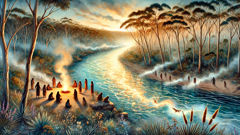
As time unfolded, other spirits arrived. Some brought seeds to scatter along the riverbanks—kangaroo paws, wattles, banksias—turning the land into a tapestry of colors and scents. Others taught the fish to swim and the birds to sing their special songs at dawn. The Wagyl watched over all these new lives, ensuring that each had its place and that the rivers flowed clear and strong. But there were also spirits of drought and fire, who grew envious of the lush abundance along the water’s edge. They threatened to scorch the earth and dry the streams. The Wagyl coiled protectively around its rivers, calling forth clouds to weep rain upon the land and sending cool mists to heal scorched places. Its presence was both fierce and gentle—a protector of order and harmony.
One day, as the world became ever more vibrant, a group of people arrived. They were the ancestors of the Noongar, drawn by the promise of water and life. They found the rivers brimming with fish, the land generous with fruits and roots, and the air alive with stories. The people quickly learned that these places were special, imbued with a power beyond their own understanding. When they camped along the riverbanks, they would see flashes of color in the corner of their eyes—a glimmer of the Wagyl’s scales beneath the surface, or the ripple of its passage through the reeds.
Elders soon taught their children the laws of country: never foul the water, never harm the places where the Wagyl rests, and always show respect to the rivers and springs. Special songs and dances were performed to honor the Wagyl and ensure the health of the land. The people made offerings at sacred pools and told stories around their campfires of how the rivers were living memory—the veins of their ancestors and the very heart of their existence. To take more than needed, or to pollute the rivers, was to risk angering the Wagyl, whose wrath could bring drought or floods.
The Wagyl itself was rarely seen by human eyes, but its presence was always felt. Sometimes, a rainbow would appear after rain, arching across the sky from one river to another. The people would whisper that this was the Wagyl moving between its homes, checking that all was well. Other times, strange whirlpools or sudden mists would rise from the water—signs that the Wagyl was near. Those who honored the laws of country were rewarded with abundance and health. Those who forgot or disrespected the rivers found their nets empty and their camps troubled by illness.
As generations passed, the stories of the Wagyl became central to Noongar identity. Children grew up knowing that every bend in the river, every rock and pool, was part of a living story. The rivers were not just places for fishing or swimming—they were sacred threads connecting people to land, to ancestors, and to the great serpent who had shaped it all.
Trials, Temptations, and Renewal
Though harmony reigned for many years, the land was not without its challenges. The spirits of drought and fire, still jealous of the Wagyl’s gift, launched attacks in hopes of claiming the rivers for themselves. Drought would parch the earth, shrinking the riverbanks and causing animals to suffer. Fires would leap across the dry grass, threatening to consume even the oldest trees. In these moments of trial, the Noongar people turned to the wisdom passed down through countless generations.
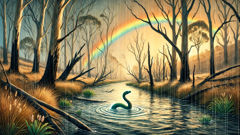
They remembered that only by honoring the Wagyl and maintaining balance could the land heal. Elders would lead ceremonies at sacred pools, singing ancient songs to call rain and appease the great serpent. The people worked together, clearing flammable brush from around camps and sharing water so that all could survive. The Wagyl watched these efforts with approval, often sending signs—a sudden rain shower breaking a long dry spell, or a new spring bubbling up where none had been before.
But there were also temptations. Sometimes, newcomers arrived who did not know the laws of country. They fished with greed, took more than they needed, or polluted the water with careless waste. The rivers responded: fish disappeared, the water grew cloudy, and sickness spread. The Noongar would warn these newcomers, sharing stories of the Wagyl’s power and the dangers of disrespecting sacred places. Some listened and changed their ways, joining in the protection of the rivers. Others ignored the warnings and suffered the consequences—losing not only their harvest but their place in this ancient web of life.
Despite these challenges, the land had a way of renewing itself. After every fire, green shoots would spring from blackened earth, and wildflowers would bloom brighter than before. The rivers would swell again with rain, and birds would return to sing new songs. The Noongar people saw these cycles as evidence of the Wagyl’s enduring presence—a reminder that creation is ongoing, that harmony must be maintained, and that every being has a role to play.
In time, even the spirits of drought and fire came to respect the Wagyl’s authority. They learned that their power was needed, too—that fire could renew forests and drought could teach patience. The Wagyl welcomed them as part of the balance, weaving their strengths into the tapestry of life. Together, they ensured that the land would always recover, no matter how great the trial.
The story of the Wagyl is not only a tale of creation but of renewal and resilience. It teaches that the land is alive, sacred, and deserving of respect—a message that echoes through time, carried by the rivers that still wind their way through southwestern Australia today.
Conclusion
Even as cities grow and bridges span the ancient rivers, the story of the Wagyl endures. For the Noongar people—and for anyone who pauses to listen—the rivers are more than scenery; they are living links to an ancient spirit and reminders of our shared responsibility to care for the land. When you walk along the banks of the Swan or Canning River, notice how each bend and billabong holds echoes of the serpent’s passage. The rustle of reeds in the breeze, the shimmer on the water at dawn, and the chorus of frogs after rain are all traces of the Wagyl’s continuing presence. To honor these stories is to honor the country itself. They teach us that creation is not a single event but an ongoing relationship—a partnership with nature, shaped by respect and gratitude. The Wagyl’s legacy flows on in every drop of water, every living thing that calls these rivers home, and in every heart that remembers. As long as the rivers run, so too will the story of the Wagyl—winding, unbroken, from the Dreaming to today.


